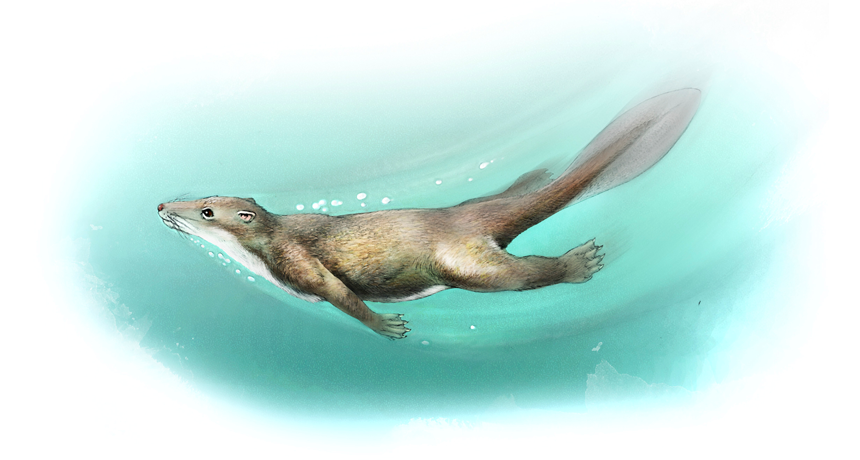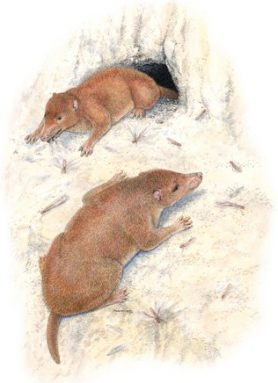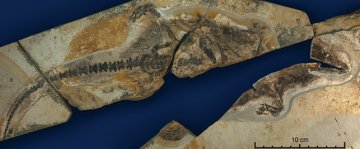Mammals in the shadow of dinosaurs
Not all early mammals that lived in the age of dinosaurs were shy and retiring.

Webbed feet and a beaverlike tail hint that Castorocauda, a close relative of mammals, spent much of its life in the water.
Jose Antonio Penas/Science Source
By Emily Sohn
Dinosaurs spent 170 million years on Earth before they suddenly died out about 65 million years ago. After dinosaurs disappeared, mammals took over.
It turns out that small mammals lived during the reign of dinosaurs, too. And over the last few years, a flurry of new discoveries has revealed what these creatures were like.
They were not the pathetic, little creatures that scientists had previously imagined. In fact, these mammals were well-adapted to their habitats, and they survived alongside dinosaurs quite well.
Last year, for example, researchers looked at the remains of a chipmunk-like creature that lived 150 million years ago. Fossils included a lower jaw, skull fragments, and 40 percent of a skeleton.
 |
|
This ancient mammal, called Fruitafossor, could dig and feasted on termites and other insects.
|
| Illustration courtesy of Mark A. Klingler/Carnegie Museum of Natural History |
Based on their size, shape, and arrangement, the animal’s foot and limb bones indicate that it did a lot of digging. It’s the first animal of that era shown to have this type of behavior.
Also last year, paleontologists analyzed two skeletons of a type of predator that belonged to the genus Repenomamus. These mammals lived in China about 130 million years ago.
One species of Repenomamus is the largest mammal yet discovered from the dinosaur age. It measured 1 meter (3.3 feet long) and weighed up to 14 kilograms (31 pounds). It looked like a badger.
Another species of Repenomamus was about the size of an opossum. One specimen was found with the remains of a baby dinosaur in its stomach (see “Dino Takeout for Mammals”).
“These are spectacular discoveries,” says Jason A. Lillegraven, a paleontologist at the University of Wyoming in Laramie. “They show a degree of diversification [of early mammals] that we hadn’t recognized before.”
The most recent addition to the growing list of ancient mammals is called Castorocauda lutrasimilis, which means “beaver-tailed creature that looks like an otter.” It lived about 164 million years ago in northeastern China.
At 50 centimeters (19.7 inches) long, Castorocauda was about the size of a platypus. It probably weighed some 800 grams (1.8 pounds). That’s more than 10 times heavier than other mammals living at that time.
Castorocauda‘s remains include the oldest fossilized fur yet found. Its body was covered by a thick layer of fur underneath an outer coat of long, stiff guard hairs. Like modern beavers, leathery scales and guard hairs covered the creature’s tail, which probably helped it swim.
 |
|
Castorocauda fossil.
|
| Photo: Luo/Carnegie Museum of Natural History |
The animal’s back teeth were shaped like the teeth of modern seals and were useful for both biting and grinding food. Like seals, it probably ate fish and invertebrates that lived in the water.
Until recently, most evidence that scientists had of these unique mammals came from fossilized teeth. While plentiful and well-preserved, teeth can reveal only so much. Future finds should help scientists piece together the history of mammalian evolution, both during the time of dinosaurs and beyond.—E. Sohn
Going Deeper:
Perkins, Sid. 2006. Out of the shadows. Science News 169(March 18):173. Available at http://www.sciencenews.org/articles/20060318/bob11.asp .
You can learn more about ancient swimming mammals at www.carnegiemnh.org/news/06-jan-mar/022306caud.htm (Carnegie Museum of Natural History).
Sohn, Emily. 2005. Dino takeout for mammals. Science News for Kids (Jan. 19). Available at http://www.sciencenewsforkids.org/articles/20050119/Note2.asp .







